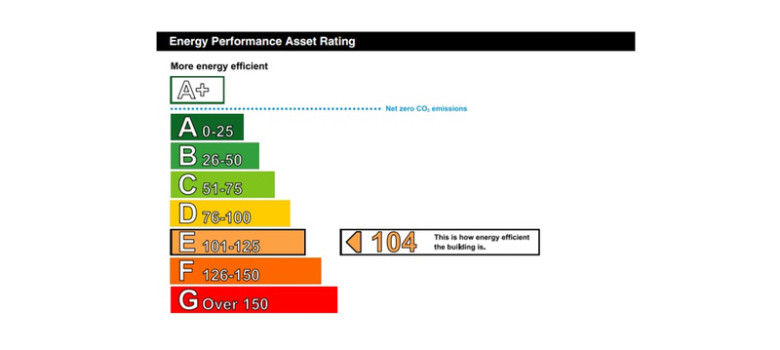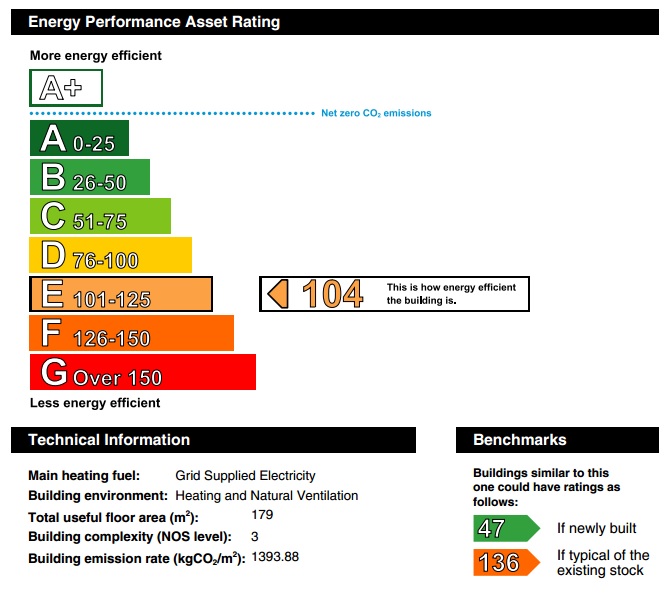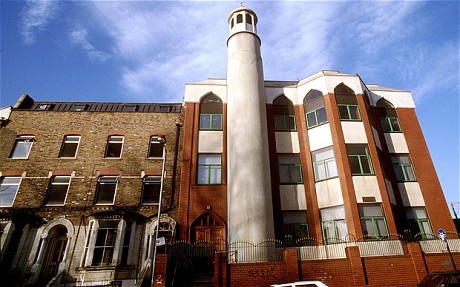
What is a commercial EPC?
Commercial Energy Performance Certificates (EPC) are energy surveys that determine how energy efficient a building or commercial premises is. The ratings on a commercial EPC start from G (least energy efficient), going up to an A for the most energy efficient building possible.
The history of London is long and varied and as a result there is quite a diverse stock of commercial premises across the city. Take for example the retail and service providers in central parts of London, these are housed in Georgian and Victorian properties – which whilst fantastic to look at, are not very energy efficient.
Conversely, newer premises such as the Shard, Wembley Stadium and the Olympic Park were all built very recently so all comply with the most stringent energy efficiency and management standards. There are obviously millions of properties across London and one of the things that makes our job so interesting is that they all vary so much in terms of their energy efficiency.
Although a commercial EPC indicates the energy efficiency of building fabric and the installed heating, ventilation, cooling and lighting systems (building services), it does not take into account how the present occupier uses these systems. This is planned with the roll-out of the commercial Green Deal (yet to be announced).
Why were commercial EPCs introduced?
EPCs were introduced by the European Union initiative (Directive 2002/91/EC – EPBD) to help drive energy efficiency across all the member states.
As energy consumption is increasing, so are CO2 emissions that go hand in hand with it. Therefore this directive was designed to address two high level challenges:
- Reduce harmful CO2 emissions that are a by-product of non-renewable energy production;
- Ensure energy supplies are secured and maintained in the medium and long-term.
At a national level (the UK), this directive ensures that member states implement some of these key principles:
- Develop consistent methods for assessing the energy performance in buildings and some of the installed building services, e.g. heating, ventilation and cooling
- Provide a set of minimum standards for new buildings and work on improvement on large buildings
- Provide certificates of buildings that state its performance and in some circumstances have those certificates for public display
- Suggest improvements for efficiency on heating, ventilation and cooling systems
- Raise the awareness of the occupiers and other energy users about the energy efficiency of their properties
When would I need a commercial EPC?
In London, as in all parts of the UK, if you are looking to rent or sell the commercial premises or the building has just been constructed then a commercial EPC will need to be undertaken – this is a legal requirement. This is to provide the ‘economic agent’ (the prospective buyer or tenant) with the most updated information on the property’s energy efficiency.
Commercial EPCs are valid for 10 years from the time when they are produced. Any new EPC produced after the original simply replaces it. A property can only have one valid commercial EPC at any one moment. Please note if the building goes through a significant update, i.e. change of use, changes to the fabric, significant extension additions to the property and/or changes to the provision of fixed services then a new EPC will have to be produced. Also if there are modifications to the existing premises after the original transaction date then a new EPC should be produced.

Can you get away with not having a commercial EPC?
It is the responsibility of local building control officers, new build inspectors and planning at a local authority level to perform regular checks for EPCs when the property exchanges hands or when it has been built. In addition if the building is serviced by air-conditioning units (above 12kWs), they have to have inspection certificates in place – and reviewed every 5 years.
Enforcement agencies have the power to investigate and request a copy of the EPC, the accompanying recommendations report and any applicable air-conditioning report. The responsible person has 7 days to produce this documentation upon request.
The penalty for failing to produce a valid commercial EPC to any prospective buyer or tenant when selling or letting non-dwellings is fixed, in most cases, at 12.5% of the rateable value of the building. There is a minimum fine of £500 though and a maximum penalty of £5,000 and you still need to produce the report after this! Where the above formula can’t be applied, there is a default £750 fine.
When is a commercial EPC not required?
A commercial EPC is not a statutory requirement if the building is a non-public existing building and is not exchanging ownership or occupancy.
There are other circumstances when it is not required:
- Buildings primarily used as places of worship (for example, Finsbury Park Mosque)
- Temporary constructed buildings, which have a lifespan of less than 2 years
- Industrial and agricultural sites that have a low heating demand – for example a barn with no HVAC system would be exempt
- Standalone buildings, which have a floor area less than 50m2
- Protected buildings that have a designated environmental or historical merit
Potential benefits of a commercial EPC
Like the domestic dwellings market, commercial buildings are also being assessed in far greater numbers, which is increasing transparency and making comparability a lot easier from building to building.
Energy prices have seen a significant increase over the last 5-7 years, so much so that we have seen a doubling of the cash price paid for energy over the same period. This makes the running costs of a building quite high on the agenda of the people that actually occupy it – in most cases they are looking to minimise them!
A commercial premises has a much greater thirst for energy during the working day – not only powering the heating system, but also powering mechanical ventilation and cooling. The key is to have an energy efficient building that isn’t expensive to run, because if you are based in London where business rates and rent is high, this can push you over the edge.
How is the EPC produced?
There are three types of commercial EPC that can be produced:
- Level 3 building – simple building (no air conditioning), e.g. typically your high street shops (inner-city London, suburban parts) with domestic premises above
- Level 4 building – standard building with air-conditioning, e.g. new office blocks with climate control, any other building with air-conditioning
- Level 5 building – building with a complex structure that requires special software to model, e.g. Westfield West London, Wembley Stadium (as seen above) and City Hall have atria and therefore need complex modelling to determine the energy rating
The commercial EPC produces an actual building emissions rate or the BER, based on the fabric and the installed business services. This can be compared to the target emission rate (TER), which is the rate if the building was constructed to today’s buildings regulations.
The higher the BER relative to the TER, the higher the CO2 emissions and the lower the EPC rating – remember A is the best rating whilst G Is the worst.
Note that the EPC doesn’t take into account how energy is used – so even though the energy rating of a building is poor, the energy bills may be very low, because the owners don’t heat and light it very much.
The Commercial EPC Process
To kick off the EPC process, a qualified assessor will need to visit the property and carry out a physical inspection of all the key components (building fabric, lighting, business services), taking into account any changes that have happened to the building over time. During the visit the assessor will determine the ‘activities’ for various parts of the property, sub-diving and grouping and then measuring those activity areas into zones. All the measurements from the zones are separately recorded in the software and when added up at the end should equal to the total size of the building.
Sometimes the information about the building adaptations may not be obvious from the inspection and additional information will be sought from the person commissioning the EPC.
Typical information that maybe asked to provide additional clarification on:
- Planning reports showing when various extensions and alterations were completed
- Serial numbers for heating, mechanical ventilation and cooling systems
- Information on renewables
If the information is not provided and cannot be evidenced, then the assessor is obliged to revert to ‘default’ values, which will suppress the rating. However if supplementary and adequate information is provided, then the assessor will be able to override those values and help produce an EPC with a better score.

Who can undertake a commercial EPC?
For Level 3 and Level 4 buildings, the Simplified Building Energy Model (SBEM) is used and to be honest this will capture most commercial properties out there. The Dynamic Simulation Model (DSM), can be applied to calculate Level 5 buildings. Assessors need to have to have the right level of qualification to be able to lodge the reports for these varying levels. For example a Level 4 assessor will be able to produce reports for Level 3 and Level 4 buildings but not a Level 5 building.
For new buildings being commissioned in the design stage, only a Level 4/5 assessor will be able to help with this request.
When all the data is entered into the software, it should produce the EPC certificate and a separate Recommendations Report. They are both then lodged onto register (managed by Landmark in England & Wales).
The recommendation report that is produced shows ways the building’s energy efficiency could be improved. The fabric and the construction of the building has the biggest impact on the rating, followed by the building services and renewables. When the EPC is produced, it will kick out a raft of different recommendations for improvement, sub-divided into short-term, medium-term and long-term payback measures.
It is up to the assessor producing the report to use his/her best judgement, taking into account the building, business activities and long-term aspirations, to suggest the most appropriate recommendation measures. If done properly, this process can produce genuine value added insight on energy efficiency to the intended users of that particular building.
As mentioned London has many old commercial buildings, all diverse and very much spread out across a vast geographical area. It therefore goes without saying that the recommendation reports should flag up a whole number of energy efficiency improvements that can be implemented.
Commercial EPC Authenticity
When the Commercial EPC is correctly lodged, it will produce a RRN number, which is located on the top right hand side of the certificate. The certificate can be searched for independently by any prospective buyer or occupier on the non-domestic registry website (www.ndepcregister.com) as long as they have this RRN number.
If assessors send across an EPC without this information then the certificate is not lodged and you will be liable if the matter is investigated by building control.
Interested in a Commercial EPC?
If you are interested in booking a EPC for your business or commercial premises, fill out the form below with your details and someone from London EPC will get in touch to discuss your requirements. Prices start at £99+VAT, but will vary on the size of the property and the number of ‘zones’ in the building.















We got Alan to come around and produce a commercial EPC for our premises near Farringdon. He was incredibly useful and we received our draft commercial EPC the very next day. Once we provided a couple of final details he sent through the proper report. If you are looking to get a commercial EPC done in London, I would look no further than these guys. A prompt, professional service – highly recommended.
Nice blog. This is a very good blog on commercial epc quotes. I would like to thank you for all the information you give. Its really important to choose the best EPC quotes. So thenks for the information you give.